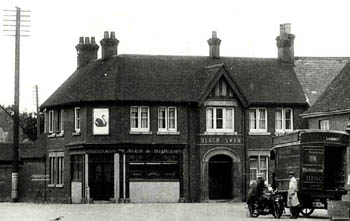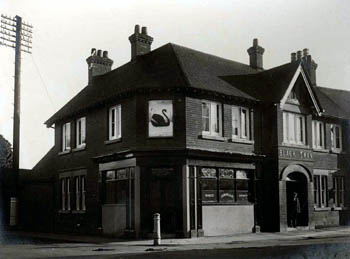The Cornerstone Public House Shefford

Black Swan about 1930 [Z50/101/3]
Black Swan Public House: 1 High Street, Shefford
The premises may not look like it but the Black Swan is one of the oldest surviving licensed business in the town. The building does not appear old, suggesting that the original building was pulled down and the public house rebuilt, perhaps by Thomas Jarvis between 1873 and 1910 or Charles Wells at some date after 1910.
The first mention of the Black Swan in any document held by Bedfordshire & Luton Archives & Records Service in 1689 when it was mortgaged by William Barber to Richard Lambert of Pavenham, yeoman, for £160 [WL499]. William Barber died in 1695 and devised the inn to his wife Anne [WL502], by 1699 she had married John Streate as they are shown consenting in an assignment of the mortgage to Grace Cadwell of Goldington, widow, in January of this year [WL501]. At this date the inn is described as having an adjoining cottage and malthouse and an orchard of one acre between the west of the chapel (now the church) to the east of the Shefford to Hitchin road as well as two acres near the Wooden Bridge adjoining Bedford Road and four acres at Claypit Corner abutting the Hitchin road to the west and on Clifton Hill.
A number of further assignments follow ending, ultimately in an assignment to Samuel King of Shefford Hardwicke, yeoman who, in his will of 1727 [WL507], devised the Black Swan to his wife Mary. This shows that at some point the Streates, or their successors, must have conveyed the property to King, presumably realising that they could not repay the mortgage. King did not die until 1756 and five years later his daughter Elizabeth, who had married a Shefford innholder (presumably landlord of the Black Swan) named William Higginson, joined her husband in mortgaging the inn to Joseph Squire of Shefford, baker for £100 [WL508]. By this date the adjoining malthouse had become a wheelwright's shop. Two years later the mortgage was assigned to Mary Squire of Hitchin, shopkeeper [WL509].
In 1791 Charlotte Higginson, both her parents being dead, sold the Black Swan to Bedford brewers Whittingstall and Long for £500 [WL514]. This firm was a partnership between brother James and Henry Whittingstall and William Long. By 1803 Henry Whittingstall was dead and, in that year, James sold his half of the business to William Long. William Long was Mayor of Bedford four times and was knighted in 1814. On his death his business passed to his son-in-law Robert Newland who later passed it to his son Bingham. On Bingham Newland's death in 1873 his business was bought by Thomas Jarvis who was, in turn, bought out by Charles Wells in 1910.

Black Swan about 1925 [WL800/1]
Like any longstanding public house the Black Swan has seen its fair share of murky deeds. The Bedfordshire Times of 13th May 1854 carried a report from the Biggleswade Petty Sessions which stated that George Webb, hawker, was charged on suspicion of stealing three ten-pound notes, one five-pound note, and seven sovereigns from the bedroom of William Bell at the Black Swan on the 9th May. Webb was, however, discharged. Two years later the Bedfordshire Times for 8th November 1856 reported that John Dymock, a railway labourer [the railway was being built through Shefford at this date], was charged by William Bell, landlord of the Black Swan, with stealing a pair of shoes, value 10 shillings on 1st November. Dymock pleaded guilty and was committed to Bedford Gaol for 7 days' hard labour.
In 1875 George Daniels, sergeant of police at Shefford summonsed landlord John Charles Revis for serving Charles Rider of Shefford with beer when licensed premises were required to be closed [HF147/3/671]. Revis was fined and charged costs but this was, presumably a first offence, since his licence was not endorsed. Finally, the Bedfordshire Mercury of 3rd October 1891 reported: "Last week a man who appears to be known in the neighbourhood was lodging at the Black Swan. On Saturday he departed by the evening train to Hitchin taking with him the landlady’s gold watch, three rings and some Jubilee coins. It is stated that the robbery was not discovered until Sunday afternoon, consequently the delinquent had a good opportunity for getting clear off".
In 1927 the town of Shefford was valued under the Rating Valuation Act 1925; every piece of land and building in the country had to be assessed for rates to be paid on it. The valuer visiting the Black Swan noted [DV1/C289] that rent was £20 per annum, the same as before the Great War. The premises was: "Corner house. Excellent building". It comprised a tap room, private bar ["v small"], parlour ["good"], cellar, private living room and kitchen downstairs and four bedrooms and a boxroom above. Outside was a stable for three horses, a coach house and a 2 bay open hovel. Weekly trade was half a barrel, three dozen pint bottles and two dozen half pint bottles of beer and a gallon of spirits. This gave weekly takings of £9. The valuer commented: "Trade seems small for position but only one 18 gallon barrel on tap in cellar and 1 untapped. Also one 18 of bitter tapped. £27 [rateable value] looks absurdly low for this house. It is a house however which has never done well. Cannot state reason but this is the fact". By January 2012 the Black Swan had been renamed the Cornerstone.

Black Swan January 2008
References:
- WL499: mortgage from William Barber to Richard Lambert of inn called Black Swan: 1689;
- WL502: will of William Barber devising Black Swan to his wife Anne: 1695;
- WL501: assignment of mortgage to Grace Cadwell: 1699;
- WL504: assignment of mortgage to William Mason of Bedford, apothecary: 1703;
- WL505: assignment of mortgage to Elizabeth Boteler of Biddenham, widow: 1706;
- WL505: assignment of mortgage to John Peck of Bedford, draper: 1709;
- WL506: assignment of mortgage to William King of Caxton [Cambridgeshire], gentleman: 1715;
- WL507: probate of will of Samuel King of Shefford Hardwicke, yeoman devising Black Swan to his wife Mary: 1727, proved 1756;
- WL508: mortgage by William and Elizabeth Higginson to Joseph Squire: 1761;
- WL509: assignment of mortgage to Mary Squire: 1763;
- WL514: conveyance by Charlotte Higginson to Whittingstall & Long: 1781;
- BS956: recital that property had been assigned to Edward Jackson as trustee for Henry Whittingstall: 1791;
- BS956: deed to lead to the uses of a fine and assignment of terms to attend the inheritance - Henry and James Whittingstall and William Long to Edward Jackson as trustee: 1792;
- BD815-816: conveyance of his half of the business from James Whittingstall to William Long: 1803;
- M10/5/831: discussion by H.O.Roe of Baldock as to the title of the Black Swan: 1819;
- CLP13: register of alehouse licences: 1822-1828;
- ABP/W1826/4 & ABP/I4/263 Will & Inventory of William Langton: 1826;
- ABP/W1840/1 Will of John Caherty – simply appointing Louisa Ann Caherty his wife as executrix and sole legatee: 1840;
- Bedfordshire Times: theft at inn: 1854;
- Bedfordshire Times: theft at inn: 1856;
- WL622: purchase of land near the Black Swan by Bingham Newland to be added to the site: 1866;
- HF143/1: Register of Alehouse Licences - Biggleswade Petty Sessional Division: 1872-1873;
- GA487: sale catalogue of Bedford Brewery and licensed houses: 1873;
- HF143/2: Register of Alehouse Licences - Biggleswade Petty Sessional Division: 1874-1877;
- HF147/3/671 Deposition of George Daniels, sergeant of police at Shefford with summons: John Charles Revis, keeper of the Black Swan, Shefford for serving Charles Rider of Shefford with beer when licensed premises were required to be closed. Fine and costs but not to be endorsed on license: 1875;
- HF143/3: Register of Alehouse Licences - Biggleswade Petty Sessional Division: 1878-1881;
- HF143/4: Register of Alehouse Licences - Biggleswade Petty Sessional Division: 1882-1890;
- Bedfordshire Mercury: robbery by lodger at inn: 1891;
- HF143/5: Register of Alehouse Licences - Biggleswade Petty Sessional Division: 1891-1900;
- HF143/6: Register of Alehouse Licences - Biggleswade Petty Sessional Division: 1900-1914;
- PSBW8/1: Register of Alehouse Licences - Biggleswade Petty Sessional Division: 1903-1915;
- PK1/4/8: auction sale held at Black Swan: 1907;
- WL800/1 pg.23: photograph: c.1925;
- DV1/C/289: rating valuation: 1927;
- PSBW8/2: Register of Alehouse Licences - Biggleswade Petty Sessional Division: 1956-1972;
- PSBW8/3: Register of Alehouse Licences - Biggleswade and North Bedfordshire Petty Sessional Divisions: 1976-1980.
- WL722/21: Black Swan featured in article in Charles Wells in-house magazine Pint Pot: 1977
List of Licensees:
note that this is not a complete list; entries in italics refer to licensees where either beginning or end, or both, dates are not known:
1689-1695: William Barber;
1695: Thomas Kent;
1761: William Higginson;
1785: John Seeley;
1792: Samuel Bullin;
1802: John Plowman;
1822-1824: William Langton;
1824-1840: John Caherty;
1853-1856: William Bell;
1861-1876: John Charles Revis
1876-1878: Edwin Hall;
1878-1886: John Richard Powdrill;
1886: Samuel Webb;
1891-1894: Thomas Russell;
1894-1896: Henry Beard;
1896-1897: Harry Lewis;
1897-1907: Frank Jackson;
1907-1909: Robert Dillon;
1909-1910: James Compton;
1910-1928: Robert Dillon;
1931-1940: Alfred Thomas Dear;
1945: Dorothy A Holmes, Edith E.Dear;
1957-1962: Charles Sorrell;
1962-1963: Joseph Michael Conners;
1963-1967: Jack Ball;
1967-1969: Sydney Frederick George Pakes;
1969-1973: Anthony John Twistleton;
1973-1974: Michael John Albert Littlechild;
1974-1975: Joseph Flynn;
1975-1976: Leslie Gledhill;
1976-1978: Leslie James Harvey;
1978-1988: James William Plester;
1988-1992: David John Porter;
1992-1993: Anthony William Thornton;
1993-1995: Norman Woodcraft